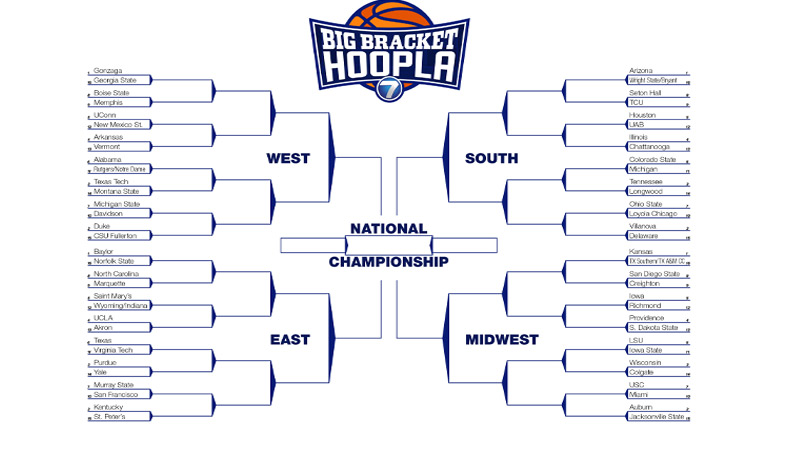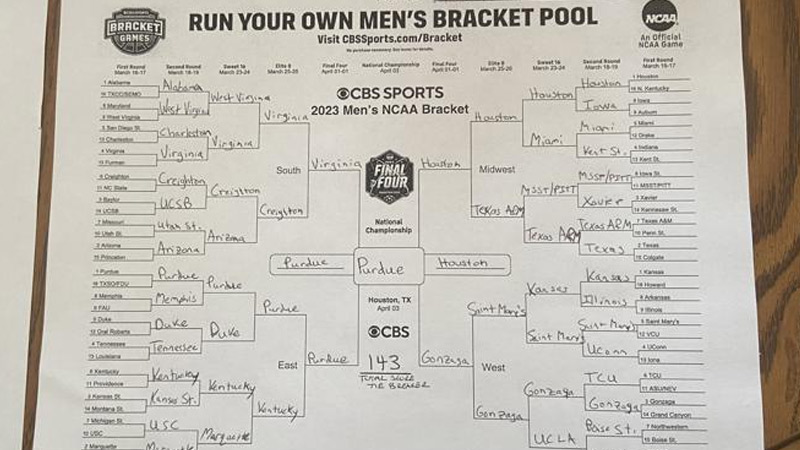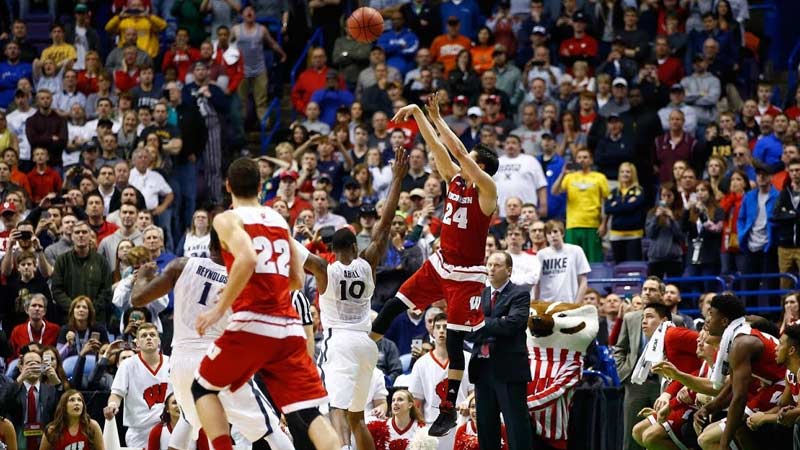March Madness is an exhilarating time for basketball fans as they eagerly fill out their brackets and make predictions for the NCAA Division I Men’s Basketball Tournament.
Filling out a March Madness bracket is a cherished tradition that combines strategy, analysis, and a dash of luck.
In this blog post, we will provide a comprehensive guide on how to fill out a March Madness bracket, helping you navigate the process and increase your chances of making accurate predictions.
From studying team information and analyzing matchups to considering seedings and historical trends, we will cover the key steps to help you approach your bracket with confidence and excitement.
What Is March Madness Bracket?
The March Madness bracket is a visual representation of the tournament’s format and serves as a tool for fans to make predictions about the outcomes of each game.
It consists of a grid that displays all 68 participating teams, their seedings, and their potential matchups throughout the tournament.
The bracket starts with the Round of 64, where the 68 teams compete to advance to the Round of 32, Sweet Sixteen, Elite Eight, Final Four, and ultimately the championship game.
Fans fill out their brackets by selecting which teams they believe will win each game, progressing through each round until they determine the national champion. The goal is to accurately predict the winners and advance the chosen teams in the bracket as far as possible.
The March Madness bracket is often used in bracket challenges and office pools, where participants compete against one another to see who can make the most accurate predictions and potentially win prizes.
Where to Get the Bracket?

Source: whio.com
The March Madness bracket is widely available from various sources, both online and offline. Here are some popular places where you can obtain the bracket:
NCAA Official Website
The official website of the NCAA (ncaa.com) typically provides the official March Madness bracket. You can find the bracket on their website as soon as it is announced during Selection Sunday.
Sports Websites
Many sports websites, such as ESPN, CBS Sports, and Bleacher Report, offer downloadable and printable brackets. These websites often provide interactive brackets as well, where you can fill out and track your predictions online.
Mobile Apps
There are mobile apps dedicated to March Madness and college basketball that offer the bracket as a feature. Examples include the NCAA March Madness Live app, ESPN Tournament Challenge, and CBS Sports March Madness.
Print Media
Newspapers and sports magazines often include the March Madness bracket in their sports sections leading up to the tournament. You can check your local newspaper or sports publications for a printed version of the bracket.
Social Media
March Madness brackets are commonly shared on social media platforms like Twitter, Facebook, and Instagram. Following official NCAA accounts, sports analysts, and basketball enthusiasts can help you find brackets shared by these sources.
Remember, the bracket becomes available once the selection committee announces the tournament field and seedings on Selection Sunday. Be sure to check these sources close to the tournament date to obtain the most up-to-date and accurate version of the March Madness bracket.
When Should You Fill Out the Bracket?

Source: fltimes.com
It is recommended to fill out your March Madness bracket after the selection committee announces the tournament field and seedings on Selection Sunday. Selection Sunday typically takes place on the second Sunday of March, a week before the tournament begins.
The specific date may vary slightly from year to year, so it’s important to check the NCAA’s official announcements or reliable sports news sources for the exact date.
Filling out your bracket shortly after the field is announced allows you to have the most accurate and up-to-date information about the teams participating in the tournament.
It gives you the opportunity to analyze the matchups, consider team performance, and factor in any recent developments, such as injuries or changes in player availability.
This will help you make more informed predictions and increase your chances of creating a competitive bracket.
Waiting until after Selection Sunday also ensures that you have the complete bracket with all the teams, including those that competed in the First Four play-in games.
This allows for a more comprehensive approach when making your predictions for the Round of 64 and beyond.
Strategies for Filling Out a Bracket
When it comes to filling out a March Madness bracket, there are various strategies you can employ to increase your chances of success.
While the tournament is known for its unpredictability, these strategies can help you make more informed predictions and maximize your bracket’s potential. Here are some strategies to consider:
Balanced Approach
A balanced approach involves considering both favorites and underdogs. While higher-seeded teams are generally more successful, upsets are a common occurrence in March Madness. Look for opportunities to select a few well-researched underdogs that have the potential to surprise.
Seeding and Historical Trends
Seeding can provide valuable insights. Higher seeds often have better records and stronger teams. Historically, 1st and 2nd seeds have the highest success rates, but upsets happen.
Consider historical trends when making your predictions, but don’t be afraid to go against the grain if you have solid reasoning.
Matchup Analysis
Analyze the matchups and playing styles of the teams. Look for matchups where a particular team’s strengths align with another team’s weaknesses. Consider factors like team defense, rebounding ability, and offensive firepower to assess potential advantages and disadvantages.
Statistics and Metrics
Dive into team statistics and metrics such as scoring averages, field goal percentages, rebounding margins, and defensive efficiency. These numbers can provide insights into teams’ overall performance and help you make more informed decisions.
Regular Season Performance
Take into account a team’s regular-season performance. How did they fare against tough opponents? Did they perform well in their conference? Teams that performed consistently well throughout the season are likely to carry that momentum into the tournament.
Conference Tournaments and Recent Form
Consider how teams performed in their respective conference tournaments leading up to March Madness. Teams that performed strongly in their conference tournaments may have gained momentum and confidence. Assessing a team’s recent form can provide valuable insights into their current level of play.
Injuries and Suspensions
Stay updated on injuries, suspensions, or any other significant player absences. A key player’s absence can greatly impact a team’s performance and potentially open up opportunities for upsets.
Gut Feelings and Personal Preferences
Sometimes, following your intuition or personal preferences can add an element of fun to your bracket. If you have a hunch or a strong affinity for a particular team, don’t be afraid to trust your instincts.
Remember, no strategy can guarantee a perfect bracket due to the unpredictable nature of March Madness. However, employing a combination of these strategies and doing thorough research can improve your chances of creating a competitive bracket and enjoying the tournament to the fullest.
How Many Brackets Teams Need to Fill in March Madness?
In March Madness, each team participating in the tournament needs to fill out one bracket. The bracket serves as a visual representation of the tournament’s format and allows teams to track their progress as they advance through each round.
It helps teams keep track of their potential opponents, the path to the championship game, and the results of each game played.
Filling out a bracket is an essential organizational tool for teams as they navigate through the tournament, and it provides a sense of excitement and anticipation as they strive to make a deep run and ultimately compete for the national championship.
How Do You Fill Out A March Madness Bracket?
Filling out a March Madness bracket involves making predictions about the outcomes of each game in the tournament. While there is no foolproof method for filling out a perfect bracket, here’s a step-by-step guide to help you approach the process:
Step 1: Obtain the Bracket
Get a copy of the March Madness bracket from reliable sources such as the NCAA’s official website, sports websites, mobile apps, or print media.
Step 2: Study Team Information
Familiarize yourself with the participating teams. Research their regular-season performance, conference tournament results, key players, playing style, and any recent news or injuries that may impact their performance in the tournament.
Step 3: Analyze Matchups
Assess the matchups in each round, considering factors like team strengths, weaknesses, playing styles, and potential upsets. Look for teams that may have favorable matchups or a history of success in the tournament.
Step 4: Consider Seedings and Historical Trends
Take into account the seedings assigned to each team. Higher-seeded teams generally have better records and are expected to perform well. Consider historical trends and the success rates of different seeds, but also be aware that upsets can and do happen in March Madness.
Step 5: Evaluate Statistics and Metrics
Dive into team statistics and metrics, such as scoring averages, field goal percentages, rebounding margins, and defensive efficiency. These numbers can provide insights into a team’s overall performance and help you make more informed decisions.
Step 6: Factor in Conference Tournaments and Recent Form
Consider how teams performed in their respective conference tournaments leading up to March Madness. Teams that performed strongly in their conference tournaments may have gained momentum and confidence. Assess a team’s recent form and consider if they are peaking at the right time.
Step 7: Trust Your Gut
Sometimes, your intuition or personal preferences can play a role. If you have a hunch or a strong affinity for a particular team, don’t be afraid to trust your instincts. March Madness is known for its unpredictability, and following your gut feeling can add an element of fun and excitement to your bracket.
Step 8: Make Your Picks
Begin filling out your bracket by selecting the winners for each game, starting from the Round of 64 and progressing through each round to the championship game. Fill in your predictions based on the analysis and considerations you’ve made.
Step 9: Consider Different Bracket-Filling Methods
Choose the bracket-filling method that suits your preferences. Some people prefer filling out the entire bracket at once, while others prefer a progressive approach, advancing teams round by round. Tailor your approach to the specific contest or pool you’re participating in.
Step 10: Double-Check and Finalize
Review your bracket, ensuring that you haven’t made any mistakes or overlooked any important factors. Once you’re confident with your picks, finalize your bracket and submit it before the tournament begins.
March Madness is renowned for its surprises and upsets, and even the most well-researched brackets can be easily busted. Enjoy the excitement, embrace the unpredictability, and appreciate the thrill of the tournament as you watch your bracket unfold.
FAQs
When should I fill out my March Madness bracket?
It is recommended to fill out your bracket after the selection committee announces the tournament field and seedings on Selection Sunday. This ensures you have the most accurate and up-to-date information about the participating teams.
How do I research team information for my bracket?
Research team information by studying regular-season performance, conference tournament results, key players, playing style, and any recent news or injuries that may impact a team’s performance in the tournament. Sports websites, statistics databases, and reliable news sources can provide valuable insights.
Should I consider historical trends and seedings?
Yes, historical trends and seedings can offer valuable guidance. Higher-seeded teams generally have better records and are expected to perform well. However, upsets are a common occurrence in March Madness, so it’s essential to strike a balance between following trends and considering potential surprises.
How do I evaluate matchups for my bracket?
Assess matchups by considering team strengths, weaknesses, playing styles, and potential upsets. Look for favorable matchups and consider a team’s success in previous tournaments. Analyze how different styles of play may affect the outcome of a game.
Can I trust my intuition when filling out my bracket?
Yes, trusting your intuition can add an element of fun and excitement to your bracket. March Madness is known for its unpredictability, and sometimes a gut feeling or personal preference can lead to memorable picks. Just be mindful of balancing intuition with research and analysis.
Wrapping Up
Filling out a March Madness bracket is an exciting and engaging process that allows basketball enthusiasts to immerse themselves in the tournament’s thrill and unpredictability.
By researching team information, analyzing matchups, considering seedings and historical trends, and trusting your instincts, you can approach your bracket with confidence.
While there are no guarantees in March Madness, these steps can help you make informed predictions and maximize your enjoyment of the tournament.
So gather your knowledge, embrace the excitement, and get ready to fill out your March Madness bracket with enthusiasm and anticipation for the unforgettable moments that lie ahead. Have a nice day.







